美国社会经济集群中增长和萎缩地区的特征
IF 5.4
2区 地球科学
Q1 GEOGRAPHY
引用次数: 0
摘要
使用类型学定期检查社会经济特征的地理差异。这样的类型学然后被用来理解可能影响结果的过程。例如,去工业化、移民和国际化的结果引起了人们对正在经历人口下降和相关经济困境的地方的关注。随着郊区化的兴起,大量的文献集中在郊区模式上。很少有研究将美国作为一个整体来考察,以了解相似和不同,或者是什么使人口团结和分裂。研究指出,直到最近,郊区的增长是以牺牲农村地区为代价的,但农村地区并不总是被纳入美国地区的类型。本文的目标是使用邮政编码级别的数据来找到不同的社会经济集群。结果表明,一些集群具有区域性模式,但其他集群在全国范围内存在。都市圈呈现出明显的集群布局。我们还在每个集群中发现了不同的模式,在人口增长的地区和人口下降的地区之间有明显的区别。本文章由计算机程序翻译,如有差异,请以英文原文为准。
Attributes of growing and shrinking places within socioeconomic clusters in the United States
Geographical variation in socioeconomic characteristics is examined on a regular basis using typologies. Such typologies are then used to understand processes that may have influenced the outcomes. For example, the outcome of deindustrialization, migration, and internationalization has drawn attention to places that are experiencing population decline and related economic distress. With the rise of suburbanization, a large body of the literature has focused on suburban patterns. Very few studies examine the United States as a whole to understand similarities and differences or what unites and divides the population. Studies note that until recently the suburban gains have been at the expense of rural regions, but rural areas are not always incorporated in the typology of U.S. places. A goal of this paper is to use data at the level of ZIP codes to find distinct socioeconomic clusters. The results show that some clusters have regional patterns but others exist across the nation. Metropolitan areas display distinct arrangements of clusters. We also find distinct patterns within each cluster, with clear distinctions between those areas that are growing and those that are experiencing population decline.
求助全文
通过发布文献求助,成功后即可免费获取论文全文。
去求助
来源期刊

Applied Geography
GEOGRAPHY-
CiteScore
8.00
自引率
2.00%
发文量
134
期刊介绍:
Applied Geography is a journal devoted to the publication of research which utilizes geographic approaches (human, physical, nature-society and GIScience) to resolve human problems that have a spatial dimension. These problems may be related to the assessment, management and allocation of the world physical and/or human resources. The underlying rationale of the journal is that only through a clear understanding of the relevant societal, physical, and coupled natural-humans systems can we resolve such problems. Papers are invited on any theme involving the application of geographical theory and methodology in the resolution of human problems.
 求助内容:
求助内容: 应助结果提醒方式:
应助结果提醒方式:


